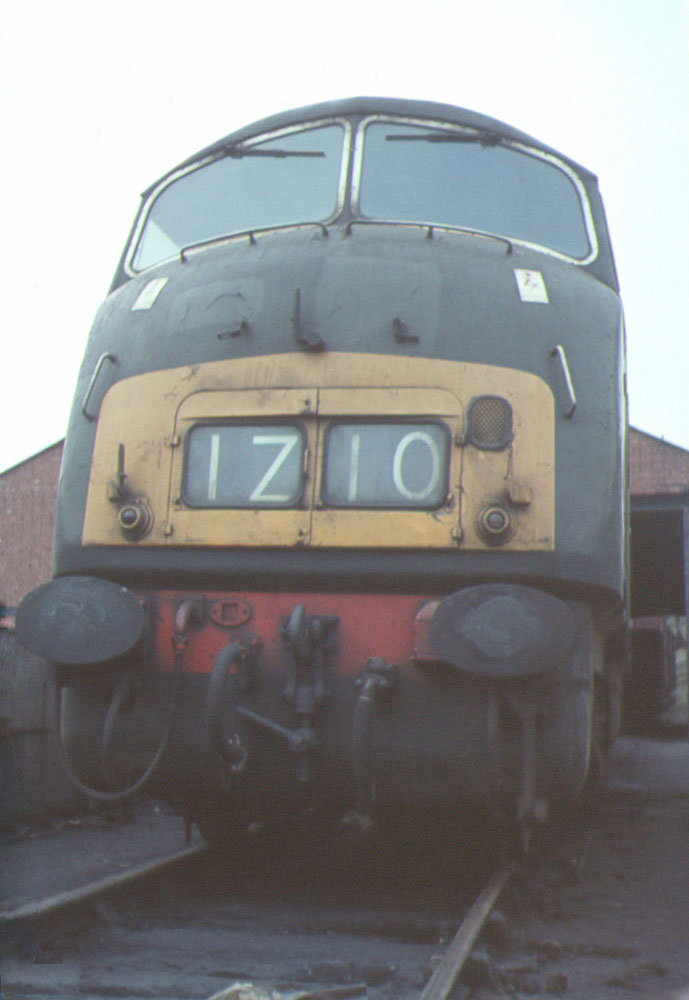- British Rail Class 43 (Warship Class)
Infobox Locomotive
name = British Rail Class 43
powertype = Diesel-hydraulic
caption = D852 "Tenacious" at Old Oak Common, 1964
roadnumber = D833–D865
totalproduction = 33
nicknames = “Warship”
builder =North British Locomotive Co.
builddate = 1960–1962
serialnumber = 27962–27994
gauge = RailGauge|ussg|lk=on|al=on
primemover = NBL-MAN L12V 18/21, 2 off
transmission = Hydraulic, Voith LT306r
whytetype = B-B
uicclass = Bo'Bo'
wheeldiameter = convert|3|ft|3+1/2|in|m|3|abbr=on
minimumcurve = convert|4.5|chain|m|lk=in
trainbrakes = Vacuum
locobrakeforce =
wheelbase = convert|48|ft|3|in|m|2|abbr=on
length = convert|60|ft|0|in|m|2|abbr=on
width = convert|8|ft|10|in|m|2|abbr=on
height = convert|12|ft|0+1/2|in|m|2|abbr=on
weight = convert|79.50|LT|sigfig=3|abbr=on|lk=on
topspeed = convert|90|mph|km/h|0|abbr=on|lk=on
poweroutput = "Engines:" convert|1100|bhp|0|abbr=on|lk=on × 2
tractiveeffort = "Maximum:" convert|49030|lbf|kN|sigfig=3|abbr=on|lk=on
fuelc
convert|800|impgal|abbr=on|lk=on
trainheating = Steam
multipleworking = ◆ White Diamond
axleloadclass =Route availability 7 (RA 6 from 1969)
railroad =British Railways
retiredate = 1969–1971TheBritish Rail Class 43 diesel-hydraulic locomotives were built by theNorth British Locomotive Company (NBL) from1960 -1962 .Classification
The D800 series diesel-hydraulic 'Warship Class', of B-B
wheel arrangement , was constructed by two different builders. Those locomotives built by British Railways at Swindon Works were originally numbered D800-D832 and D866-D870. They were allocated Class 42 with the advent ofTOPS , while those built by theNorth British Locomotive Company (NBL) were originally numbered D833-D865 and allocated Class 43. Because of their early withdrawal dates, neither the Swindon- nor the NBL-built locomotives carried TOPS numbers. More detail on factors common to both types can be found in the article on the Swindon-built locomotives.Mechanical details
The NBL-built D800s differed mechanically from the Swindon-built batch: the Swindon locomotives used Maybach engines connected to Mekydro hydraulic transmissions whereas the NBL-built examples used MAN engines and Voith transmissions. NBL had entered into an arrangement with the German company MAN AG in the early 1950s to market MAN's engine designs in the UK: NBL were anxious to enter the diesel locomotive market, especially once it became apparent that
British Rail ways would be seeking large quantities of such locomotives when the "Modernisation Plan" was announced. MAN were equally keen to obtain a slice of the UK market for themselves. The first results of this collaboration were the D600-D604 locomotives which failed to take advantage of the weight-saving potential of light alloy stressed-skin construction allied to hydraulic transmissions. No further examples of this design were ordered but NBL then received an order for 33 locomotives to a more advanced design, the D800 design drawn up by Swindon Works. The prime mechanical components of these were two MAN L12V18/21B diesel engines, each rated at 1100hp at 1530rpm and coupled to a Voith LT306r hydraulic transmission; each engine/transmission combination drove one bogie. Unlike the Mekydro four-speed transmissions in the Swindon-built locomotives, the Voith was only a three-speed design but was chosen because it kept compatibility with D600-4 and because NBL already had a licence to manufacture it. Whereas the Swindon-built locomotives had all their engines and transmissions supplied by the German manufacturers (albeit with ten engines and three transmissions supplied as kits of parts for the British licensee to re-assemble) the engines and transmissions required for D833-65 were all built by NBL.Operation
In operational service, the NBL locomotives were less reliable than their Swindon-built cousins. Mild steel was used for the
exhaust manifold s and these components were prone to fracture. Not only did this result in a loss of exhaust pressure to drive the turbochargers but also the driving cabs rapidly filled with exhaust fumes. The MAN-built engines used in the GermanDB class V 200 design had nickel-resist steel manifolds and were far less troublesome. The engine design also suffered from being quite highly rated for a design with no active piston cooling andpiston ring life expectancy was decreased as a result. One MAN L12V18/21B was sent to the British Internal Combustion Engine Research Association for various tests and potential modifications to improve the deficiencies but nothing ever came of this. Further problems arose because of the conversion from metric to imperial feet and inches when the MAN drawings were received by NBL. It is almost certain that rounding errors in these conversions resulted in poor tolerances and lowered reliability in practice. Despite all this figures for 1965 show the North British Warships covering a far greater annual mileage than contemporary type 4's such as the Westerns , Peaks and Brush type 4.Withdrawal
The NBL-built D800s were withdrawn before their Class 42 sisters, themselves doomed to a short life because of the decision to standardise on diesel-electric transmission for mainline locomotives. None have survived into preservation. They were allocated to Bristol Bath Road, Laira Plymouth, Newton Abbot and Old Oak Common.
References
*cite journal | last = Marsden | first = Colin J | title = The Warships | journal =Modern Railways Pictorial Profile| issue = 12 | pages = p10 | publisher = Ian Allen Ltd | location = Weybridge | date = February - April 1986 | unused_data = |ISSN 0264 3642
Wikimedia Foundation. 2010.
